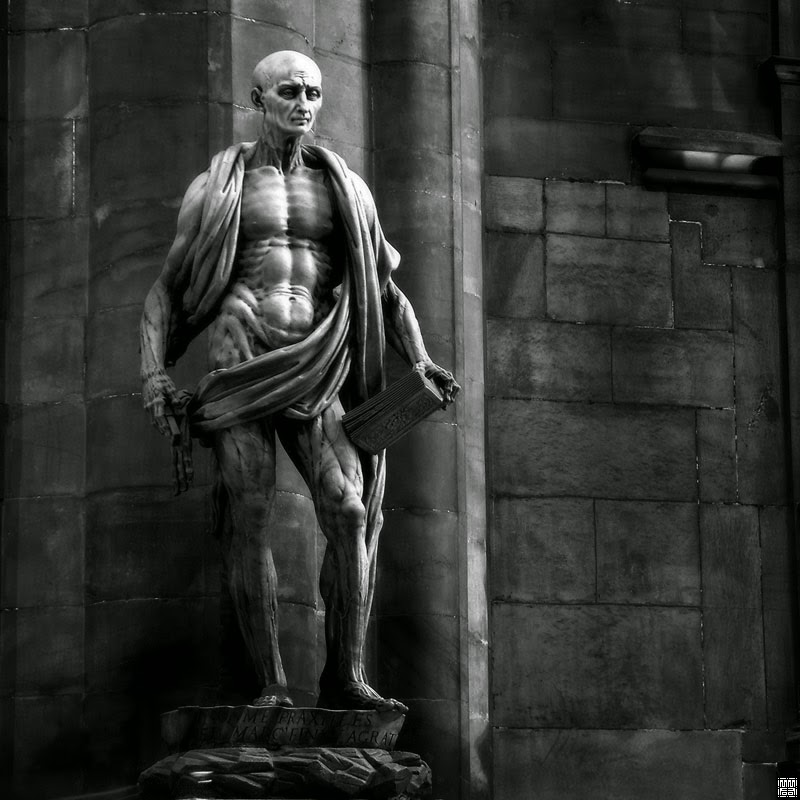by
1562
Bartholomew the Apostle - Wikipedia, the free encyclopedia: Bartholomew (Greek: Βαρθολομαῖος) was one of the Twelve Apostles of Jesus, and is usually identified with Nathanael (alternatively spelled Nathaniel),[1] who appears in the Gospel according to John as being introduced to Christ by Philip, who would also become an Apostle.[Jn 1:43-51] He is also identified as "Nathanael of Cana in Galilee" in John 21:2.
Bartholomew (Greek: Βαρθολομαῖος, transliterated "Bartholomaios") comes from the Aramaic bar-Tôlmay (בר-תולמי), meaning son of Tolmay[2] or son of the furrows (perhaps a ploughman). Bartholomew is listed among the Twelve Apostles of Jesus in the three Synoptic gospels: Matthew,[10:1–4] Mark,[3:13–19] and Luke,[6:12–16] and also appears as one of the witnesses of the Ascension[Acts 1:4,12,13]; however, each time he is named in the company of Philip. He is not mentioned in Gospel of John. Nor are there any early acta,[3] the earliest being written by a pseudepigraphical writer who assumed the identity of Abdias of Babylon and called the Saint-Thierry Manuscript and Pseudo-Abdias Manuscripts.[4][5]
Alternatively, Bartolomew has been identified with Nathanael, as presented in the Gospel of according to John. [1:45–51] Nathanael is introduced as a friend of Philip. He is described as initially being skeptical about the Messiah coming from Nazareth, saying: "Can anything good come out of Nazareth?", but nonetheless, follows Philip's invitation. Jesus immediately appraises him as "Here is a man in whom there is no deception." Some scholars[who?] hold that Jesus' quote "Before Philip called you, when you were under the fig tree, I saw you", is based on a Jewish figure of speech referring to studying the Torah. Nathanael recognizes Jesus as "the Son of God" and "the King of Israel". He reappears at the end of John's gospel[21:2] as one of the disciples to whom Jesus appeared at the Sea of Galilee after the Resurrection.
Christian tradition has three stories about Bartholomew's death: "One speaks of his being kidnapped, beaten unconscious, and cast into the sea to drown. Another account states that he was crucified upside down, and another says that he was skinned alive and beheaded in Albac or Albanopolis",[18] near Başkale, Turkey.
The account of Bartholomew being skinned alive is the most represented in works of art, and consequently Bartholomew is often shown with a large knife, holding his own skin (as in Michelangelo's Last Judgment), or both. Bartholomew is also the patron saint of tanners.
Bartholomew plays a part in Francis Bacon's Utopian tale New Atlantis, about a mythical isolated land, Bensalem, populated by a people dedicated to reason and natural philosophy. Some twenty years after the ascension of Christ the people of Bensalem found an ark floating off their shore. The ark contained a letter as well as the books of the Old and New Testaments. The letter was from Bartholomew the Apostle and declared that an angel told him to set the ark and its contents afloat. Thus the scientists of Bensalem received the revelation of the Word of God.[19]
Of the many miracles performed by Bartholomew before and after his death, two very popular ones are known by the townsfolk of the small island of Lipari.
The people of Lipari celebrated his feast day annually. The tradition of the people was to take the solid silver and gold statue from inside the Cathedral of St Bartholomew and carry it through the town. On one occasion, when taking the statue down the hill towards the town, it suddenly became very heavy and had to be set down. When the men carrying the statue regained their strength, they lifted it a second time. After another few seconds, it got even heavier. They set it down and attempted once more to pick it up. They managed to lift it but had to put it down one last time. Within seconds, walls further downhill collapsed. If the statue had been able to be lifted, all the towns people would have been killed.
During World War II, the Fascist regime (German/Italian) looked for ways to finance their activities. The order was given to take the silver statue of St Bartholomew and melt it down. The statue was weighed, and it was found to be only a few grams. It was returned to its place in the Cathedral of Lipari. In reality, the statue is made from many kilograms of silver and it is considered a miracle that it was not melted down.
St Bartholomew is credited with many other miracles having to do with the weight of objects.
***
After visiting Beverly Elliot at St. Bartholomew, then stopping by Beth Jacob synagogue; definitely church is all about the woman and indoctrinating their children young.
The western wall is in the daytime...
these men dreading going home to their wives at night!
They are all a conniving scheming bunch...
business as usual.











No comments:
Post a Comment